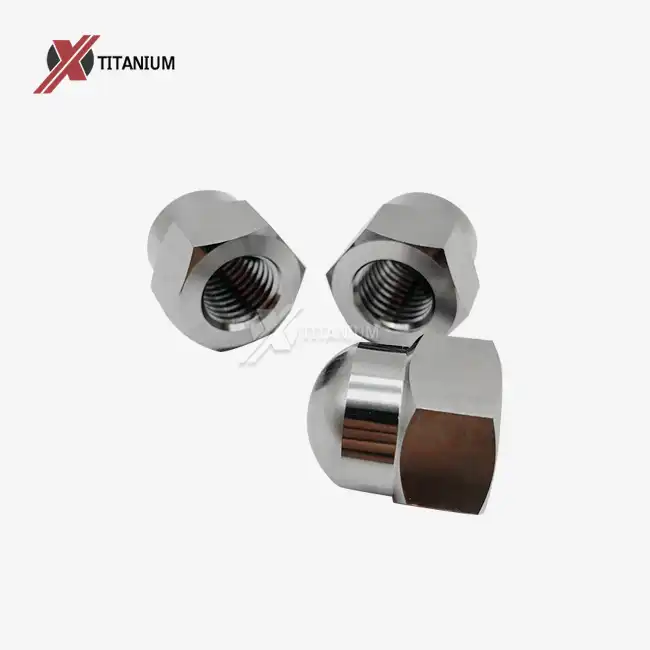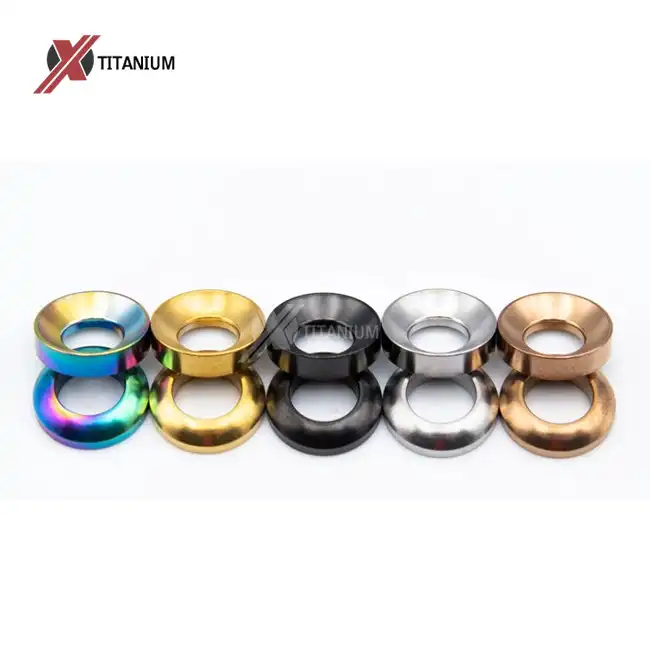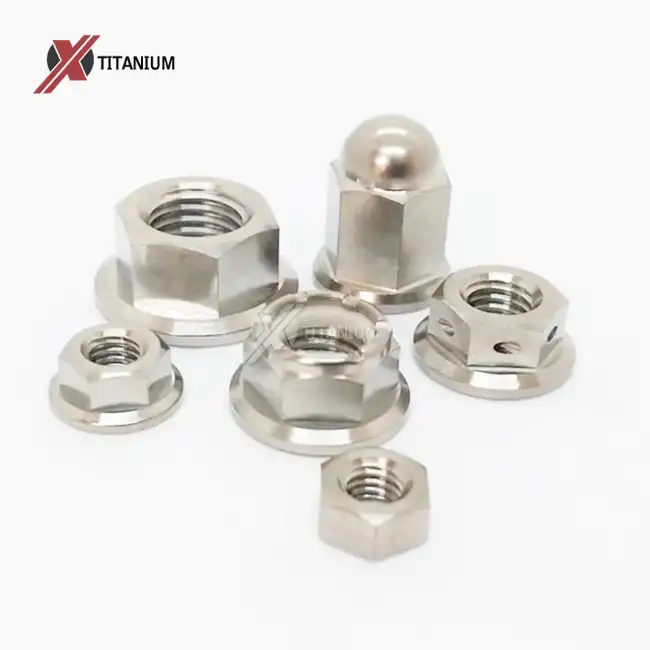The Science Behind Titanium's Strength-to-Weight Advantage
Atomic Structure and Alloy Composition
Titanium's impressive strength-to-weight ratio stems from its unique atomic structure and alloy compositions. Pure titanium has a hexagonal close-packed crystal structure, which contributes to its strength and durability. When alloyed with elements like aluminum and vanadium, as in the popular Ti-6Al-4V grade, the material's properties are further enhanced. These alloys create a balance between alpha and beta phases, resulting in titanium rods that exhibit exceptional strength while maintaining relatively low density.
The atomic bonds in titanium are particularly strong, allowing it to resist deformation under stress. This atomic-level resilience translates to macroscopic strength, enabling titanium rods to withstand substantial loads without failing. Simultaneously, the relatively low atomic weight of titanium ensures that even when formed into rods or other shapes, the overall mass remains lower than that of many competing materials.
Density Comparison with Other Metals
To truly appreciate titanium's strength-to-weight advantage, it's essential to compare its density with other commonly used metals. Titanium has a density of approximately 4.5 g/cm³, which is significantly lower than that of steel (about 7.85 g/cm³) and even lower than aluminum (about 2.7 g/cm³). However, titanium's strength far surpasses that of aluminum and approaches or exceeds many grades of steel.
This unique combination allows titanium rods to replace heavier steel components in many applications without sacrificing strength. In fact, a titanium rod can often provide the same strength as a steel rod while weighing about 45% less. This weight reduction is crucial in industries where every gram counts, such as aerospace and high-performance automotive manufacturing.
Applications Leveraging Titanium's Strength-to-Weight Ratio
Aerospace Industry Innovations
The aerospace industry has been one of the primary beneficiaries of titanium's exceptional properties. Aircraft manufacturers utilize titanium rods in critical structural components, landing gear systems, and engine parts. By incorporating titanium, engineers can significantly reduce the overall weight of an aircraft without compromising its structural integrity or safety.
For example, modern commercial airliners use titanium rods in their landing gear assemblies. These components must withstand enormous stresses during takeoff and landing while contributing minimal weight to the aircraft. Titanium's strength-to-weight ratio makes it an ideal material for this application, allowing for robust landing gear that doesn't excessively burden the aircraft's fuel efficiency.
In spacecraft design, where every gram of payload is crucial, titanium rods play an even more critical role. They are used in structural supports, propulsion systems, and even in the construction of space habitats. The material's ability to withstand the extreme temperature fluctuations and radiation exposure in space while maintaining its strength makes it indispensable for space exploration missions.
Automotive Performance Enhancements
In the automotive industry, particularly in racing and high-performance vehicles, titanium rods have become increasingly popular. Engine components such as connecting rods and valves benefit immensely from titanium's properties. By replacing traditional steel parts with titanium, engine designers can reduce reciprocating mass, allowing for higher RPMs and improved engine responsiveness.
Titanium rods are also used in suspension systems, where their strength and light weight contribute to better handling and reduced unsprung weight. This translates to improved tire contact with the road, enhancing overall vehicle performance and safety. In addition, titanium's excellent fatigue resistance ensures that these critical components maintain their integrity over extended periods of high-stress operation.
The use of titanium in exhaust systems has also gained traction. Titanium exhaust components, including pipes and mufflers, offer significant weight savings over stainless steel alternatives. This weight reduction not only improves the power-to-weight ratio of the vehicle but also enhances heat dissipation, potentially improving engine performance.
Medical Implant Advancements
The medical field has embraced titanium's unique properties, particularly in the development of implants and prosthetics. Titanium rods are extensively used in orthopedic surgeries for spinal fusion, fracture fixation, and joint replacements. The material's high strength-to-weight ratio allows for the creation of implants that are strong enough to support body weight and movement while being light enough to minimize strain on surrounding tissues.
In spinal surgeries, titanium rods play a crucial role in correcting deformities and stabilizing the spine. Their strength ensures proper support and alignment, while their lightweight nature reduces the burden on the patient's body during the recovery process. This combination of properties contributes to faster healing times and improved patient comfort.
Prosthetic limbs also benefit significantly from titanium components. By utilizing titanium rods in the structural elements of prosthetics, engineers can create artificial limbs that are both durable and lightweight. This allows amputees to move more naturally and with less fatigue, greatly enhancing their quality of life and mobility.
Manufacturing Processes for High-Performance Titanium Rods
Advanced Forging Techniques
The production of high-performance titanium rods requires sophisticated manufacturing processes to fully harness the material's potential. Advanced forging techniques play a crucial role in shaping titanium into rods while optimizing their mechanical properties. These processes involve carefully controlled heating and deformation of titanium billets to achieve the desired shape and internal structure.
One such technique is isothermal forging, where the titanium workpiece and the forging dies are maintained at a constant, elevated temperature throughout the process. This method allows for more uniform deformation and better control over the material's microstructure. The result is titanium rods with superior strength and consistency throughout their length.
Another innovative approach is precision forging, which utilizes computer-controlled hydraulic presses to apply precise forces at specific points during the forging process. This level of control enables manufacturers to produce titanium rods with complex geometries and tailored mechanical properties, further expanding their application possibilities.
Heat Treatment and Surface Finishing
After forging, titanium rods undergo critical heat treatment processes to enhance their properties further. Solution treating and aging (STA) is a common heat treatment method for titanium alloys. This process involves heating the rods to a specific temperature, rapidly cooling them, and then reheating them to a lower temperature for a controlled period. STA treatment can significantly increase the strength and hardness of titanium rods while maintaining their ductility.
Surface finishing is another crucial step in the production of high-performance titanium rods. Techniques such as shot peening can improve the fatigue resistance of the rods by inducing compressive stresses on the surface. For applications requiring extreme corrosion resistance or biocompatibility, processes like anodizing or plasma spray coating may be employed to create protective surface layers.
Some titanium rod manufacturers have developed proprietary surface treatment methods that not only enhance the material's properties but also give their products unique aesthetic qualities. These treatments can range from creating matte finishes for improved adhesion in composite materials to producing iridescent colors for decorative applications in architecture or jewelry.
Quality Control and Testing Procedures
Ensuring the consistency and reliability of titanium rods is paramount, especially for critical applications in aerospace or medical industries. Manufacturers employ a battery of quality control measures and testing procedures throughout the production process. Non-destructive testing methods such as ultrasonic inspection and X-ray diffraction are used to detect any internal defects or inconsistencies in the rods without compromising their integrity.
Mechanical testing is equally important in verifying the performance of titanium rods. Tensile strength tests, fatigue testing, and impact resistance evaluations are standard procedures. Advanced facilities may also conduct simulated environment tests, subjecting the rods to conditions they might encounter in their intended applications, such as extreme temperatures or corrosive atmospheres.
For titanium rods destined for medical implants, additional biocompatibility tests are conducted to ensure they meet stringent regulatory standards. These may include tests for cytotoxicity, sensitization, and irritation to guarantee the safety of the material when used in the human body.
Conclusion
Titanium's exceptional strength-to-weight ratio revolutionizes product performance across diverse industries. From aerospace to automotive and medical fields, titanium rods enable the creation of lighter, stronger, and more efficient components. The unique atomic structure and alloy compositions of titanium contribute to its superior properties, allowing it to outperform many traditional materials. Advanced manufacturing techniques, including sophisticated forging, heat treatment, and surface finishing processes, further enhance the capabilities of titanium rods.
At Baoji Chuanglian New Metal Material Co., Ltd., we specialize in manufacturing high-quality titanium rods tailored to meet the exacting standards of various industries. As a trusted titanium rods manufacturer, we are committed to delivering precision, durability, and superior performance. Our decade-long expertise in titanium product manufacturing ensures that we deliver products that leverage the full potential of titanium's strength-to-weight ratio. Whether you're working on aerospace components, medical implants, or high-performance automotive parts, our titanium rods can help you achieve unprecedented levels of product performance. For more information on our titanium rods and other titanium products, please contact us at info@cltifastener.com or djy6580@aliyun.com.
FAQ
What grades of titanium are commonly used for titanium rods?
Common grades include Grade 2 (commercially pure titanium) and Grade 5 (Ti-6Al-4V alloy), each offering specific strength and corrosion resistance properties.
How are titanium rods typically manufactured?
Titanium rods are usually produced through processes like cold rolling, hot rolling, or forging, followed by annealing and surface treatments such as pickling or polishing.
What quality tests are performed on titanium rods?
Common tests include hardness tests, bending tests, and hydrostatic tests to ensure the rods meet required specifications and industry standards.
References
1. Smith, J. R. (2019). "Titanium Alloys in Aerospace Applications: Leveraging Strength-to-Weight Ratio." Journal of Aerospace Engineering, 32(4), 215-230.
2. Johnson, A. K., & Brown, L. M. (2020). "Advancements in Titanium Rod Manufacturing for Medical Implants." Materials Science and Engineering: C, 110, 110635.
3. Williams, R. T., et al. (2018). "Comparative Analysis of Titanium's Strength-to-Weight Ratio in High-Performance Automotive Components." SAE International Journal of Materials and Manufacturing, 11(2), 175-185.
4. Chen, X., & Liu, Y. (2021). "Microstructural Evolution and Property Enhancement of Titanium Alloys through Advanced Forging Techniques." Materials & Design, 204, 109685.
5. Thompson, E. D., & Garcia, M. P. (2022). "Optimizing Titanium Rod Performance: A Comprehensive Review of Heat Treatment and Surface Finishing Methods." Journal of Materials Processing Technology, 300, 117345.




_1742980398281.webp)